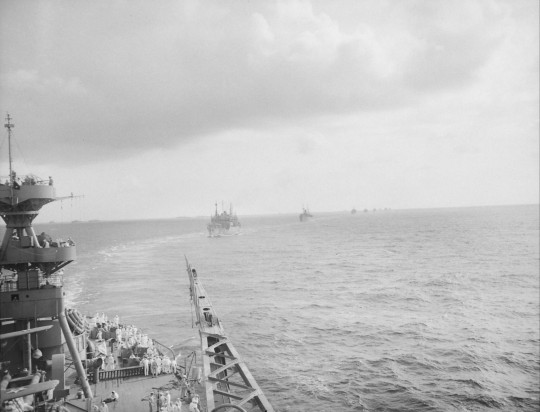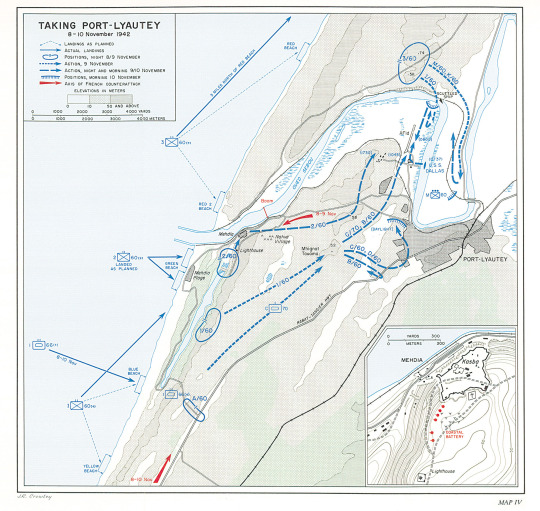#Battle of Port Lyautey
Explore tagged Tumblr posts
Text

1942 11 09 Morocco, Operation Torch, Clawed by a Wildcat - Roy Grinnell
https://mikesresearch.com/2022/03/27/air-battle-over-morocco-1942/
November 9 The battered but plucky pilots of GC II/5 were airborne at dawn with only five aircraft. They strafed landing craft at Fedhala and received such intense US Navy AA fire that three of the French Hawks were damaged severely, although all the planes returned.At 0645 hours, Tom Booth leading 7 Red Ripper Wildcats took off from the RANGER bound for Port Lyautey. John Raby’s VF-9 was close behind with eight F4F-4s ordered to patrol over Fedhala. The VF-41 pilots were straining to locate enemy targets and waiting for some direction when an air control officer with US troops radioed that a lone French plane was strafing them. Tom Booth replied to the distress call but was immediately countermanded by the ship and ordered to attack an enemy transport column on the Fedhala-Casablanca Road. In screaming dives, the Wildcats descended on the enemy truck convoy spraying it with .50 Cal machine gun fire. Booth ordered the stubby Wildcats to strafe the column again. While pulling up, they observed 6 to 8 trucks burning and another half dozen sitting at odd angles in the ditches along the chaotic road.John Raby’s VF-9 had barely reached their patrol altitude at 10,000 feet when French aircraft were spotted. A motley group of 15 LeO 451s, DB-7s and Martin 167s had just bombed landing craft on the Fedhala beachhead from high altitude with poor results. They were escorted by 16 Hawk 75s from GC I/5. Without the slightest hesitation, Raby led his 8 Wildcats against the enemy force. The French bombers got away as the fighters became embroiled in a massive dogfight.In the air battle, Wildcats and Hawks alternately became the hunter and were the hunted. The French fought and flew courageously, but the Curtiss fighters were unable to cause decisive damage to the Wildcats. On the other hand, the six .50 Cal machine guns of the F4F-4s had a devastating effect on the French fighters. Some of the French pilots had out flown the Wildcats, but they did not ready had a chance. The main reason may have been that their aerial combat tactics were those from WWI. Four planes of the Champagne Escadrille were destroyed, two pilots KIA and two other survived crash landings. Another four Hawks were damaged. VF-9 claimed 5 destroyed and 4 probables.
28 notes
·
View notes
Text
Operation Goalpost, part of Operation Torch
Part of the History of USS TEXAS (BB-35)

"When France surrendered to Germany, in June 1940, an unoccupied area of southern France was allowed to have a collaborationist French government, in Vichy, France. The French authority in Algeria and Morocco at the time of the June surrender chose to follow the Vichy government."
A large portion of the French Navy, the Marine Nationale, and the French Army, the Armée de Terre, had been moved to the French colonies in North Africa. To neutralize the threat of these forces possibly being used against the Allies, the US and Britain sent out their militaries to capture or destroy any French assets and occupy the colonies. There were several ports invaded at the same time. Including the famous battle between the incomplete French Battleship Jean Bart and USS MASSACHUSETTS (BB-59) at Casablanca, French Morocco.

TEXAS was the flagship of Task Force 34.8, which consisted of USS SAVANNAH (CL-42), USS CHENANGO (CVE-28), USS DALLAS (DD-199), USS ROE (DD-418), and several other transport ships. Their main objective was to support the US Army 9th Infantry Division, 60th Infantry Regiment's capture of Port Lyautey, as part of Operation Goalpost.

The objectives of Operation Goalpost were:
Capture the village of Mehdia.
Capture Kashah Mahdiyya, a fortress at the mouth of the Sebou River
Secure an airfield.

The TF arrived in Port Lyautey in the early morning of November 8, and TEXAS quickly maneuvered into position to bombard targets. However, the US Army was running under the pre-war tactics and prioritizing the element of surprise, rather than softening up targets beforehand. This tactic was discarded shortly after. The element of surprise had already been lost since the other landings were already ongoing.
All three of her Vought OS2U Kingfishers were launched to provide spotting and support the troops. Some of TEXAS' AA crews fired at friendly aircraft but luckily none were hit. The officer who wrote the action report, chalked this up to nervousness.


Action reports of November 8. TEXAS was assigned to the northern most landing.
After the troops landed, the Army radioed for TEXAS to bombard a munitions dump near Port Lyautey. Only turrets no. 2 and 4 were needed to destroy it, firing only 59 rounds. The pilot reported about 20% landed on target. When the Kingfishers returned that evening, one of the planes capsized due to a wing float ripped off when it landed. The pilot and radio operator were rescued unarmed. The pilot reported he had taken AA fire from French forces, likely causing the accident. This plane was not recovered and was instead deliberately sunk with gun fire.

Action report of November 10.
On November 10, the Army called for fire support to disrupt enemy troop movements. TEXAS fired from the same two turrets as before, expending 214 rounds from 0843 to 1130, and making a road and the area impassable. The pilot reported the road was littered with wreckage and stalled vehicles. This road was later repaired after hostilities had ended.
During the fire support, one of the Kingfishers noticed a motorcycle with a sidecar leaving at a high speed. Thinking it was a high ranking official, the pilot broke away and strafed the vehicle with it's M1919 Browning machine guns. This caused it to crash in a ditch. The pilot then strafed other vehicles in the area, scattering troops.

At 1435, the Army radioed requesting aerial support as French tanks and other troops were advancing on their position. The two Kingfishers from TEXAS were quickly dispatched, along with aircraft from SAVANNAH. One of TEXAS's Kingfishers was armed with a depth charge, AN-MK41, with instantaneous fuses. By the time they got there, the enemy forces were under attack by Savannah's planes and DALLAS.

These pilots joined the affray and dropped a depth charge on a tank, making a direct hit. The pilot reported the explosion flipped two other tanks over and left a giant crater in the ground.
On November 11, the Army again called for fire support and TEXAS quickly made her way to the position. However, by the time she arrived, the French forces had surrendered. In the two days of battle, she fired 272 14" shells and 6 5" shells.

"When the fighting ceased, a party from TEXAS went ashore to Port Lyautey to clear the harbor of ships the French had sunk to blockade its use. Though French resistance in the area had ceased, German submarines were still active and had sunk several ships. On November 12, submarine activity was reported in the area around TEXAS and the escort destroyers dropped depth charges. TEXAS relocated to another area and encountered submarine activity again. She sailed figure eight inside a submarine screen while more depth charges were dropped. On November 15, TEXAS and the rest of TF 34.8 departed the area and arrived back in Norfolk on the 26th."
Note: there are no surviving photos of TEXAS during the battle, if there were any. In 1942, the US Navy actively discouraged sailors from taking any kind of photographs.
Photographed by Frank Scherschel of Life Magazine.
source, source
Information from BattleshipTexas.info: link
LIFE Magazine Archives: 115883846
U.S. Naval History and Heritage Command: 19-N-33912
#USS TEXAS (BB-35)#USS TEXAS#New York Class#battleship TEXAS#Dreadnought#Battleship#USS SAVANNAH (CL-42)#USS DALLAS (DD-199)#USS ROE (DD-418)#USS CHENANGO (CVE-28)#Destroyer#Warship#United States Navy#U.S. Navy#US Navy#USN#Navy#World War II#World War 2#WWII#WW2#Operation Torch#Operation Goal Post#Battle of Port Lyautey#Mehdia#Morocco#North African Theater#November#1942#USS TEXAS History Series
68 notes
·
View notes
Text

USS TEXAS (BB-35) escorting the invasion force across the Atlantic Ocean to North Africa for Operation Torch. To the left is USS SAVANNAH (CL-42) and to the right is USS DALLAS (DD-199). A Vought OS2U Kingfisher flying over head, screening for submarines.
Note: TEXAS is painted in Camouflage Measure 12.
Artwork depicks the taskforce sometime between November 1 and 7, 1942.
"into the Storm" by Mal Wright, 2011: link, link
#USS TEXAS (BB-35)#USS TEXAS#New York Class#battleship TEXAS#Dreadnought#Battleship#Warship#Ship#USS SAVANNAH (CL-42)#Cruiser#USS DALLAS (DD-199)#USS DALLAS#Destroyer#United States Navy#U.S. Navy#US Navy#USN#Navy#World War II#World War 2#WWII#WW2#WWII History#Operation Goal Post#Battle of Port Lyautey#North African Theater#November#1942#artwork#my post
64 notes
·
View notes
Text

"On October 23, USS TEXAS (BB-35) embarked upon her first major combat operation when she sortied with Task Group (TG) 34.8, the Northern Attack Group for Operation Torch, the invasion of North Africa. The objective assigned to this group was Mehedia near Port Lyautey and the port itself. The ships arrived off the assault beaches early in the morning of November 8 and began preparations for the invasion. When the troops went ashore, TEXAS did not come immediately into action to support them. At that po int in the war, amphibious warfare doctrine was still embryonic; and many did not recognize the value of a pre-landing bombardment. Instead, the Army insisted upon attempting surprise. TEXAS finally entered the fray early in the afternoon when the Army requested her to destroy an ammunition dump near Port Lyautey. For the next week, she contented herself with cruising up and down the Moroccan coast delivering similar, specific, call-fire missions. Thus, unlike in later operations, she expended only 273 rounds of 14-inch and 6 rounds of 5-inch. During her short stay, some of her crew briefly went ashore to assist in salvaging some of the shipping sunk in the harbor. On 16 November, she departed North Africa and headed for home in company with USS SAVANNAH (CL-42), USS SANGAMON (ACV-26), USS KENNEBEC (AO-86), four transports, and seven destroyers."
"A view forward from the 20MM tub on top of turret no. 2 as USS MASSACHUSETTS (BB-59) heads into the sun on November 4, 1942, just before the Battle of Casablanca. 'Lead Dammit Lead' is stenciled on the 20mm gun shield and USS NEW YORK (BB-34) is at left, in the distance."
source
#USS Massachusetts (BB-59)#USS Massachusetts#South Dakota Class#USS New York (BB-34)#USS New York#New York Class#dreadnought#battleship#warship#ship#boat#October#1942#world war ii#world war 2#WWII#WW2#history#military#united states navy#us navy#navy#usn#u.s. navy#my post#colorized photo#colorized
61 notes
·
View notes